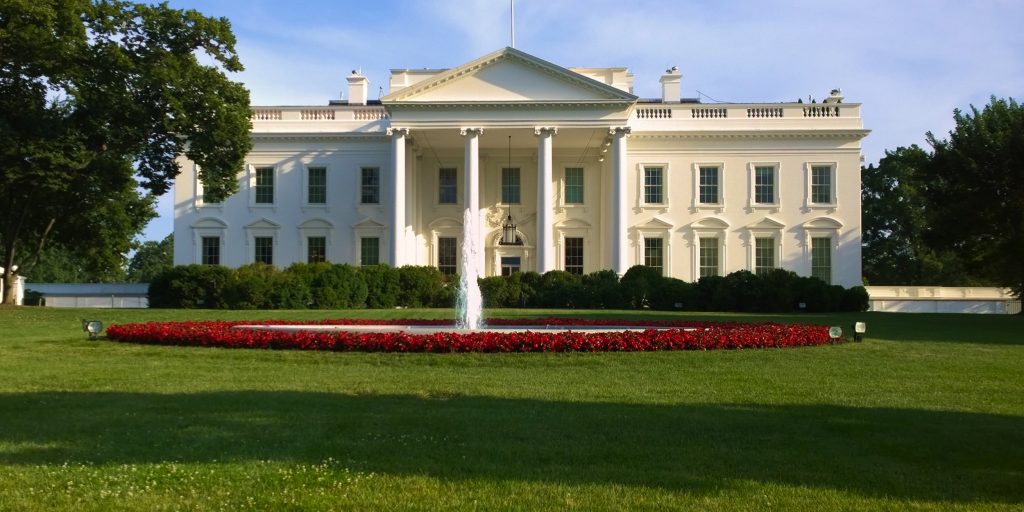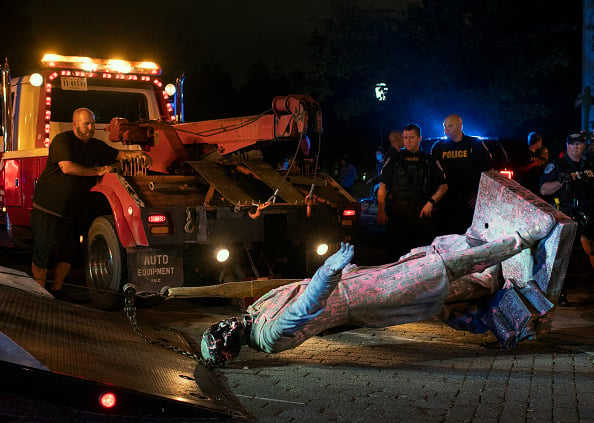Politics
Donald Trump Signs an Executive Order Calling to Prosecute Anyone Who Damages Federal Monuments ‘to the Fullest Extent Possible’
The new executive order signed Friday reinforces the Veteran's Memorial Preservation Act.

The new executive order signed Friday reinforces the Veteran's Memorial Preservation Act.

Sarah Cascone

President Donald Trump is doubling down on his support of the nation’s divisive monuments, signing an executive order on Friday that reinforces laws protecting statues across the US.
“I just had the privilege of signing a very strong Executive Order protecting American Monuments, Memorials, and Statues—and combatting recent Criminal Violence,” wrote Trump on Twitter Friday. “Long prison terms for these lawless acts against our Great Country!”
Monuments to Confederate leaders and other controversial figures such as Christopher Columbus have been targeted by activists as a wave of protests over police violence against Black people swept the world this month. The latest demonstrations have resulted in actions for which activists have long pushed, like the removal of Theodore Roosevelt’s statue from the front of the Museum of Natural History. At the same time, the monuments issue has emerged as an opportunity for political maneuvering in an election year.
Under the new order, it is “the policy of the United States to prosecute to the fullest extent possible under federal law” anyone who “destroys, damages, vandalizes, or desecrates a monument, memorial, or statue within the United States.” The federal government will withhold funding from state and local police forces that “fail to protect monuments, memorials, and statues.”

Protesters gather around the statue of Confederate General Robert E. Lee on Monument Avenue on June 6, 2020 in Richmond, Virginia, amidst protests over the death of George Floyd in police custody. Photo by Vivien Killilea/Getty Images.
Last Monday, police intervened near the White House at Lafayette Square in Washington, DC, using pepper spray to stop an attack on a statue of President Andrew Jackson—who, protesters noted, was also a slaveholder who caused the death of thousands of Native Americans by forcibly removing them from their lands through what became known as the Trail of Tears.
In response, Trump posted on Twitter threatening protestors with 10 years in jail under the Veteran’s Memorial Preservation Act of 2003, which criminalizes “attempts to injure or destroy, any structure, plaque, statue, or other monument on public property commemorating the service of any person or persons in the armed forces of the United States.” The new executive order directs the attorney general to prioritize enforcing that and other related laws.
“We are looking at long-term jail sentences for these vandals and these hoodlums and these anarchists and agitators and call them whatever you want. Some people don’t like that language, but that’s what they are. They’re bad people, they don’t love our country, and they’re not taking down our monuments,” Trump told reporters on Tuesday.
Numerous people arrested in D.C. for the disgraceful vandalism, in Lafayette Park, of the magnificent Statue of Andrew Jackson, in addition to the exterior defacing of St. John’s Church across the street. 10 years in prison under the Veteran’s Memorial Preservation Act. Beware!
— Donald J. Trump (@realDonaldTrump) June 23, 2020
The order does not mention that protestors have largely focused on Confederate monuments—most of which were erected decades after the war, following the end of Reconstruction, as a part of a “Lost Cause” myth-building campaign.
Instead, it highlights the toppling of a President Ulysses S. Grant statue in San Francisco and an abolitionist soldier in Chicago, graffiti painted on a Boston memorial to an African American Civil War regiment, and the vandalism of a World War II veterans monument in Charlotte. Also mentioned was the “influential activist”—presumably political commentator Shaun King—who “declared that many existing religious depictions of Jesus and the Holy Family should be purged from our places of worship.”
“The violent extremists’… selection of targets reveals a deep ignorance of our history, and is indicative of a desire to indiscriminately destroy anything that honors our past and to erase from the public mind any suggestion that our past may be worth honoring, cherishing, remembering, or understanding,” notes the order.

A statue of Confederate President Jefferson Davis is loaded onto a tow truck after it was pulled down off of it’s pedestal on Monument Avenue in Richmond, VA on June 10, 2020. Photo courtesy of the Washington Post via Getty Images.
The president personally asked the Washington, DC, parks department to reinstall the city’s only Confederate monument after it was torn down by protestors, according to NBC. The city’s activists have also called for the removal of the Emancipation Memorial, in which President Abraham Lincoln appears to free a kneeling black man from slavery. The artwork has been criticized for minimizing the agency of enslaved peoples.
“Although formerly enslaved Americans paid for this statue to be built in 1876, the design and sculpting process was done without their input, and it shows,” Democratic Delegate Eleanor Holmes Norton of DC, who is introducing legislation to remove the work, told ABC. “The statue fails to note in any way how enslaved African Americans pushed for their own emancipation.”